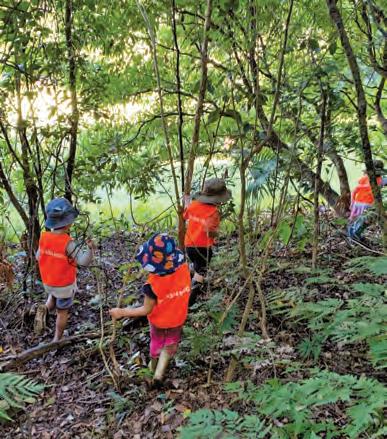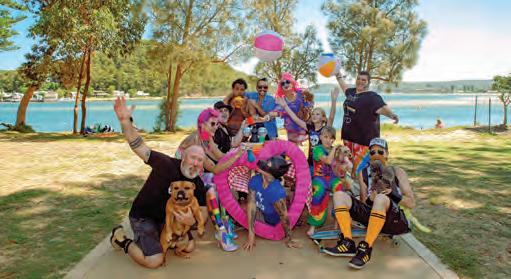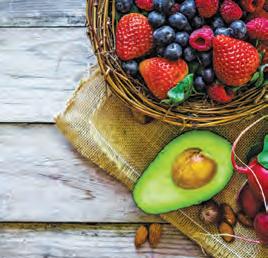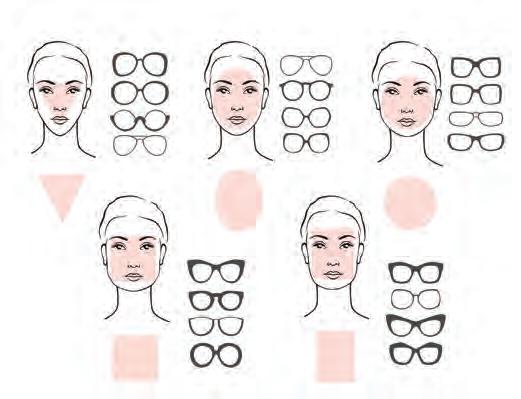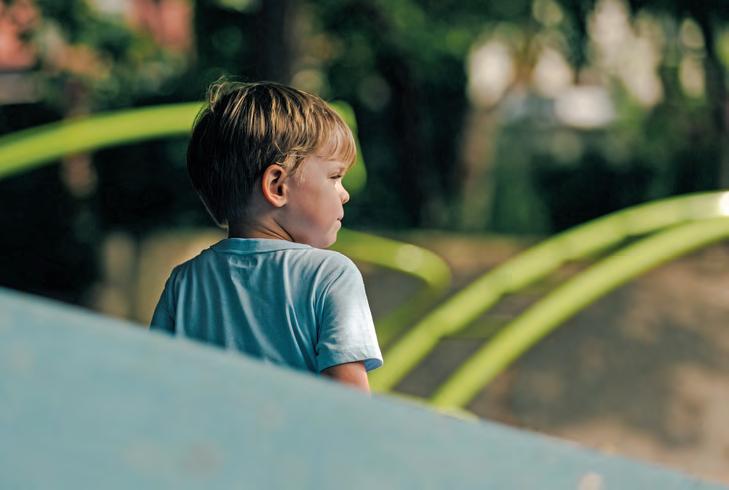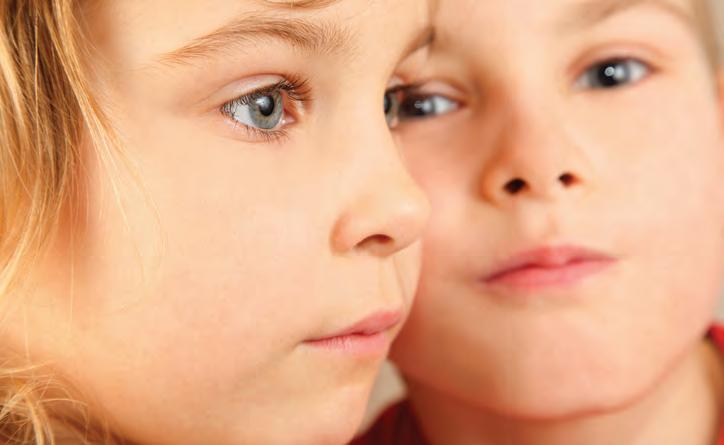
17 minute read
Breast Implant Cancer
With Dr Mary Ling, Central Coast Breast and General Surgeon Have you had implants for breast reconstruction or augmentation? The recent worldwide recall of the Allergan brand of implants due to their links to a rare form of cancer has raised many questions. Here are answers to 6 frequently asked questions...
What is Breast Implant Associated Anaplastic Large Cell Lymphoma (BIA-ALCL)? BIA-ALCL is a rare cancer of the immune system that occurs in people who have had breast implants. It is not breast cancer, but rather a type of lymphoma that grows in the scar tissue (capsule) surrounding the implant.
What is the risk? The risk of BIA-ALCL is estimated to be between 1 in 1000 and 1 in 10000, meaning 1 woman will be diagnosed with BIA-ALCL for every 1000 to 10000 women with breast implants.
The risk is significantly higher for “macro” textured (e.g. Silimed Polyurethane, Allergan Biocell) compared with “micro” textured (e.g. Mentor Siltex) implants. All Australian cases have occurred in women with textured implants (and no cases in women with smooth implants). There is no difference in risk in women who have implants for breast augmentation or reconstruction.
BIA-ALCL occurs with both saline and silicone filled implants.
What are the symptoms? The main symptoms of BIA-ALCL are
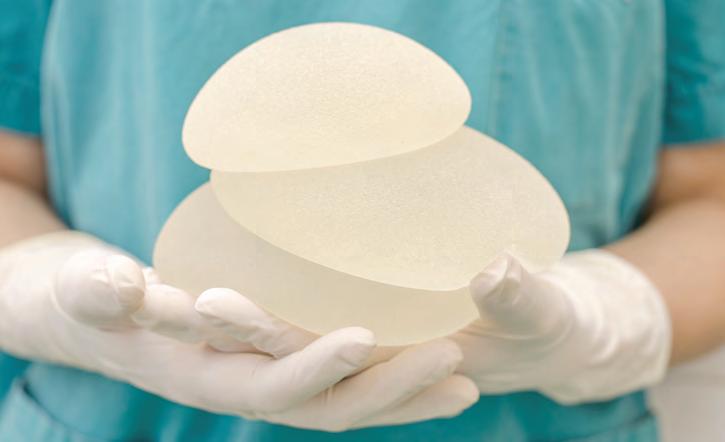
persistent breast swelling or pain. It can also present as a lump in the breast or armpit. Most cases occur between 3 and 14 years after surgery.
How is it diagnosed? An ultrasound is performed to assess for the presence of fluid. If fluid is present, a sample will be taken to look for cancerous cells. Fluid collection is common after breast implants and most are not BIA-ALCL. Mammograms are not helpful for the diagnosis.
What is the treatment? Most patients with BIA-ALCL are cured by removing the implant and the surrounding capsule.
Should implants be removed, “just in case?” It is currently not recommended that breast implants are removed in people without any symptoms. However, breast implants are not lifetime devices regardless of BIA-ALCL. Please discuss with your surgeon about regular implant checks or if you have concerns.
For updates, visit the Breast Implant Hub by Therapeutic Goods Administration www.tga.gov.au/hubs/breast-implants
Our implant story
Empire Bay theatre nurse Janis Livingstone, 67, was diagnosed with hereditary breast cancer in 2001. Her daughter, Sarah, was diagnosed with breast cancer in 2015.
“I originally had implants, but they started to encapsulate last year (become hard and misshapen). I also knew a lady with breast implants who developed ALCL and I chose to have them removed and have a TRAM-flap instead (own tissue from abdomen),” says Janis.
However, Sarah, who was treated with a 9 cm aggressive lobular cancer, opted for breast implants. “I’m comfortable with my decision because I am regularly monitored and trust my surgeon.”
Scan the QR code below to watch Janis & Sarah share their breast cancer journey
Dr Mary Ling is a Breast and General Surgeon who consults at Gosford, Woy Woy and Kanwal. & 02 4321 0302 www.drmaryling.com.au @drmaryling
*This advice is general only. All surgical procedures have risks. Speak to your doctor about your symptoms
Debunking Learning Myths
“M y left brain is stronger than my right”; “I’m a visual learner”; “Did you know we don’t even use 90% of our brain?”
We’ve all heard these statements before. We may have even said one or two or a variance of them.
We’ve come a long way since these myths first emerged. Yet a number of learning myths continue to stand the test of time despite having no grounding in scientific research.
George Orwell famously said, “Myths which are believed in tend to become true.”
What does this mean? If we believe them, we start to define ourselves and our abilities by them. Worse, we could limit our assumptions about what we can and can’t do. We start to act according to these self constructed limits and – all of a sudden – we have made the myth a reality.
In the case of learning, society has fallen deep into this trap. According to research done by Macdonald et al 1 . 68% of the public believe the following learning statements to be true. They have become so engrained in our thinking that even 56% of educators are reported to believe them too.
In this article, we seek to bust three common learning myths and help put the learning record straight.
Myth 1: Left brain vs right brain The idea that we all have a dominant side of the brain that dictates how we learn has been around for a while. Left brained people are logical, analytical and methodical. Right brained people are creative and artistic.
The truth is the left and right hemispheres of the brain actually work together. Of course, there is lateralization – where certain functions are processed by more than one region of the brain than others. But we all use our entire brain equally 2 . We can actually think both creatively and analytically thanks to the regions in our brain being connected. It’s important that we actively nurture both creative and analytic skills in ourselves and in our children. Myth 2: We only use 10% of our brains Barry Gordon, a behavioural neurologist, and cognitive neuroscientist describes this myth as incorrect. He says, “we use virtually every part of the brain, and that (most of) the brain is active almost all the time.” 3
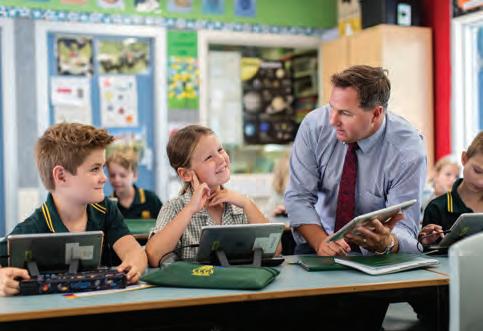
Some areas of our brain may be more active than others at any given moment, but we do use all of our brain. In fact, according to the University of Queensland 4 , our brain is the most energy intensive part of our body, using 20% of our energy even though it makes up just 3% of our weight. Now that’s food for thought.
It’s certainly true that we can make our brains stronger. But that comes through exercising it – not through unlocking a vast mass of unused grey matter.
Myth 3: Every brain is hardwired to a particular learning style Individuals have different styles of learning such as visual, auditory or kinesthetic is a common myth. There is no evidence to support the theory 5 that people learn better when they take in information by listening to it, being presented it visually or through hands on practise. In fact, if we choose to limit our learning to one particular style we may actually reduce learning and our ability to learn in the future.
Studies have found that students benefit most when learning new information in different ways – learning across multiple modes. Multiple styles of learning allow us to access richness and breadth and help lock understanding in. Mr Damon Cooper, Director of Teaching and Learning at Central Coast Grammar School explains, “Multiple styles of cognitive input require multiple areas of the brain to process that learning. As a result, we are able to access, process and connect new ideas in rich and multi-faceted ways. This creates a deeper understanding and allows us to strengthen neural pathways in more than one area of our brain.”
Dynamic learning environment and rich opportunities Central Coast Grammar School challenge their students. They understand that learning is not a predetermined biological ability. They encourage all our students to be open to developing skills, support them to think laterally and push beyond their limitations. “At Central Coast Grammar we create rich educational opportunities at every turn. We build learning experiences through a range of modes and provide a dynamic learning environment where students are actively engaged in multisensory experiences, practical activities, independent and collaborative work," says Headmaster Mr Bill Low.
"We pride ourselves on treating every individual child as a complete and unique person. It is this kind of holistic learning that helps students to grow, develop and confidently apply their understanding in meaningful ways," adds Mr Low.
Of course, don’t forget – adequate sleep, good nutrition and regular exercise will also help lay the foundations for a healthy brain and a healthy life.
Don’t let these myths become a selffulfilling prophecy. Let’s rewrite these learning myths and do the best for our children. For more information visit www.ccgs.nsw.edu.au
1 2 3 4 5 www.frontiersin.org/articles/10.3389/fpsyg.2017.01314/full www.learningscientists.org/blog/2016/8/2-1 www.scientificamerican.com/article/do-people-only-use-10-percent-of-their-brains/ https://qbi.uq.edu.au/10-amazing-facts-about-brain www.psychologicalscience.org/journals/pspi/PSPI_9_3.pdf
Finding answers – when to take your child to see a Child Psychiatrist
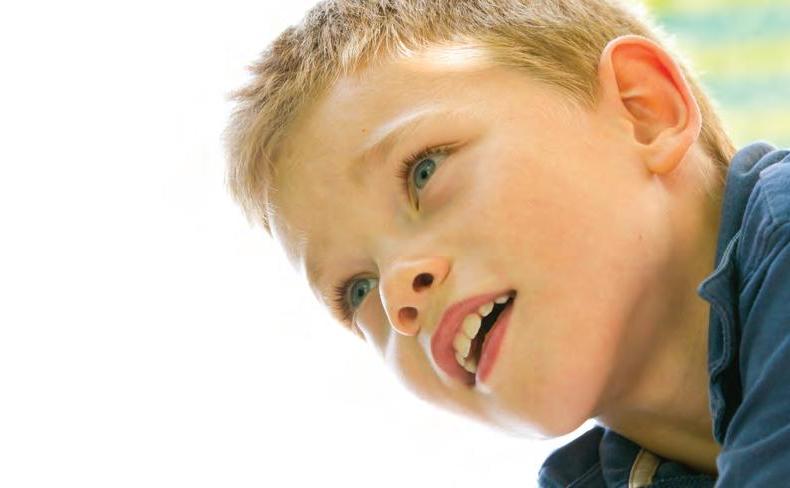
Australia’s youth are facing a crisis, and they need our help as care providers and advocates. The percentage of youth in Australia who say mental health is an issue of national importance grew from 21% to 43% between 2015 and 2018. Forty-three percent of kids say coping with stress is their top personal concern.
At the same time, as many as half of all children and adolescents in Australia receive inadequate (or no) treatment, despite meeting the criteria for mental health disorders. Kids with complex conditions have an even higher risk of inadequate care.
There are many reasons our children aren’t getting the mental healthcare they need. Often, those reasons tend to be structural and aren’t reflective of the kind of care possible for young people. Even still, if you recognise behaviours in your child that trouble you, there is something you can do to advocate for your child’s care.
And that is to bring your child to see a Child & Adolescent Psychiatrist.
Finding help for your child: The first steps Is your child struggling or experiencing emotional distress?
When it comes to a child’s health, while there may be a number of professionals may be available, but there is one often overlooked professional – the Child & Adolescent Psychiatrist.
A Child & Adolescent Psychiatrist is a medical specialist with at least five years (often longer) of further accredited rigorous specialist training under the Royal Australian and New Zealand College of Psychiatrists (RANZCP) in public hospitals where they deal with complex and acute cases of mental health. To become a Child & Adolescent Psychiatrist, a candidate has to complete at least two years of specialised training under the RANZCP in mental health work with children, adolescents, and their families. Their expertise allows them to use multiple treatment approaches – diagnostic studies, prescription medications, and several types of psychotherapy interventions.
When should you see a Child Psychiatrist? Diagnosing mental illness in children is tricky for all health professionals for several reasons. First, children may not have the vocabulary or the emotional maturity to express their feelings as they experience them. Additionally, development varies significantly between individual children, which means there’s no true timeline to follow. Finally, mental illness presents differently in children than in adults.
It is important for the psychiatrist to be directly involved in the initial assessment and management of any children displaying common signs of mental health issues. However, it becomes even more crucial among children and young people presenting with complex, severe symptoms and who face increased risk to themselves and others.
In cases where the underlying cause of problem behaviours is illness, a misdiagnosis or no diagnosis is devastating for children. Attempting other treatment options without rigorous assessment and diagnostics means you are all working to manage symptoms without acknowledging the existence of the underlying cause.
What’s worse, data shows that waiting too long is harmful for both kids and their families. As they wait for help, their ability to emotionally or cognitively function declines. The decline may cause you to lose hope that anything can change, and you both may be resistant to try care again in the future.
Although your child benefits from the work of a healthcare team (including a psychologist, paediatrician, speech therapist, etc.), both your child and the team benefit when a child psychiatrist oversees all aspects of mental health treatment. Doing so offers a clear path forward and allows all members of the team to adjust the treatment plan as one rather than as individuals.
Australia’s children are asking for help with their mental help, and we can give them the care they deserve.
Dr Sangeetha Makielan CHILD AND ADOLESCENT PSYCHIATRIST
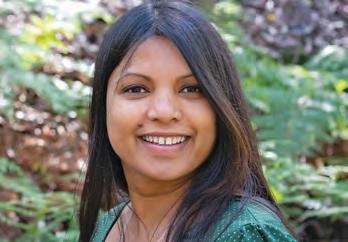
Erina Fair launches initiative to combat waste
To help combat the growing mountain of takeaway coffee cups ending up in landfill, Erina Fair Shopping Centre announced a partnership with Closed Loop, to recycle disposable cups used in the Centre. As part of Closed Loop’s Simply Cups Program, Erina Fair Shopping Centre is introducing five coffee cup recycling bins throughout the Centre and will be encouraging customers to recycle. The bins are shaped as coffee cups.
Australians use more than one billion disposable coffee cups each year. The cups are estimated to be the secondlargest contributor to litter waste, after plastic bottles. Most takeaway coffee cups end up in landfill, as the plastic lining in the cups cannot be processed in traditional recycling facilities. The plastic lining will take over 50 years to break down in landfill, and when disposed of incorrectly in a comingled or paper recycling bin, the entire bin contents are considered contaminated and sent to landfill.
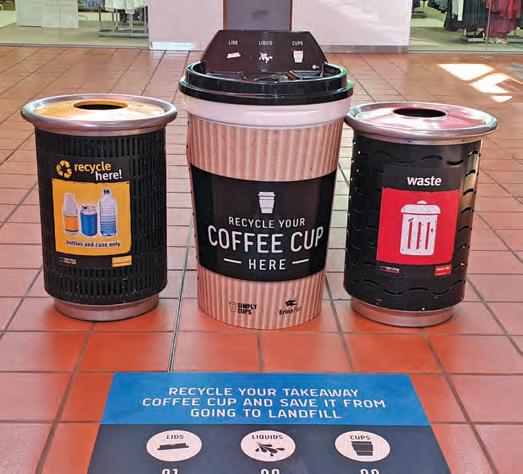
Brisbane Waters Private Hospital welcomes Dr Sangeetha Makielan CHILD AND ADOLESCENT PSYCHIATRIST Dr Sangeetha Makielan sees children under the age of 18, perinatal and postnatal mothers and families of the children and mothers. Her specialities include:
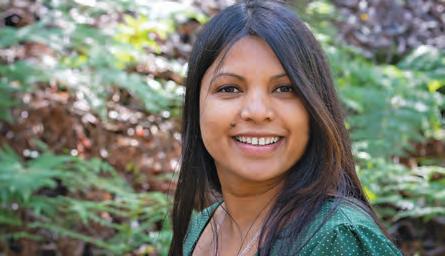
• Child and Adolescent Psychiatry, including children under the age of 18 (Anxiety, Depression, ASD, ADHD, Complex Trauma, Gender Dysphoria, School Refusal, Psychosis)
• Perinatal Mental Health – Antenatal Depression, Postnatal Depression and Postpartum Psychosis
• Perinatal and infant psychiatry (e.g. bonding difficulties) • Psychotherapy – Individual, ParentChild, Family Therapy • Psychotopic medication used during pr egnancy and breastfeeding • Adjustment difficulties with pr egnancy or parenting • Grief associated with fertility and perinatal loss • Parent-child relationship difficulties • Transcultural Psychiatry
Dr Makielan is passionate about working collaboratively with patients and offering a holistic approach to treatment to achieve optimal outcomes for infants, children and their families. Treatment is built on mutual respect, responsibility, and commitment.
For all outpatient appointments please contact Brisbane Waters Private Hospital Consulting Rooms on: T: 02 4343 0265 T: 1800 270 888 F: 02 4342 7164 E: contact@dolphintribe.com.au W: familypsychiatrist.com.au or dolphintribe.com

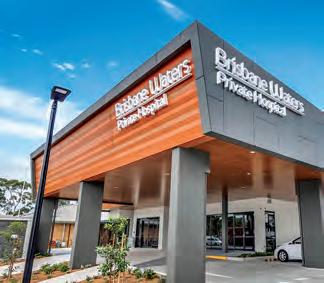
Adventures to the
beyond
Imagine cool, fresh air filling your lungs; dewy wet grass squidging beneath your gumboots; a vast amount of land before you, ready to be explored and investigated…Beyond the gates of Alkira ELC lies wild bushland ready for keen adventurers to explore. Within this beyond space there lies a pond, open grassy hills and bushland, plus much more! Here we have created our own bush tracks, discovered caves and climbed trees. We have spent time making flower crowns, tee pees, fairy dens and taken time to just be. We have scrambled up muddy hills and slid back down, learnt to hold tree roots and rocks to successfully climb to the top. Empowered with confidence and driven by determination, in nature’s authentic playground the children’s learning is real and meaningful, more importantly it’s fun! Exploring fire; The heat beaming from the pit, the sound of crackling and the dancing of the flames; the awe and wonder of fire always captivates our children. The fire pit becomes an area where the children learn to respect the concept of heat, the science behind it and what it means to us. Through teacher led discussions we delve into the possible dangers of fire to our immediate selves as well as to the environment and how we can take safety precautions. As educators, our aim is to guide the children’s learning through hands-on experie nces. It becomes the responsibility of the group to gather the natural resources they need to build a fire. We see knowledge sharing and collaboration and the children support one another in the process. With the trust we place in the children, they can take the opportunity to use a flint to spark the fire. It is a highlight for the educators to see the focus, concentration and persistence displayed by the children as they spend, what can be up to 30 minutes trying for the spark. The pure excitement and satisfaction they display when this happens is what it’s all about. The firepit naturally becomes a gathering place where we sit together sharing our thoughts and food. Led by the children, various meals are created over the fire to share together; a special time for bonding. Exploring earth; Being in an open natural space sees the children’s exploration of earth in an untouched raw place. Picture endless green tree filled hills, coastal views, algae covered ponds and the sound and sight of wildlife waiting to be explored; this is the reality for our avid adventurers. One principal emphasis our educators place on our adventures is providing the children with the time to be; to be immersed in nature without the modern day ‘toys’ and distractions of their busy lives. The children spend hours exploring every area of the space at their own pace, taking on new experiences and creating memories with their friends. This beyond space backs onto a hillside where the children and educators challenge their capacity for risk in climbing through bushland to create tracks and explore virgin bushland. As we make our way through the grass, trees and vines, we arrive at our ‘bat cave’. As we head into the dark cave on the side of the hill, you can see the children are fascinated by the dark, silent cave, adjusting their eyes to see if any creatures are hiding in there. As our adventures to the beyond run
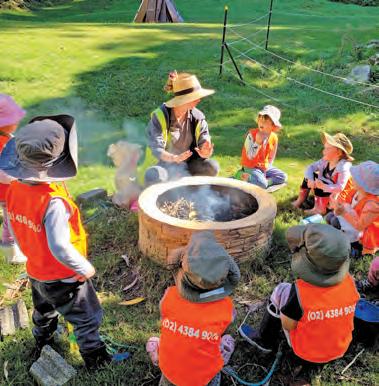
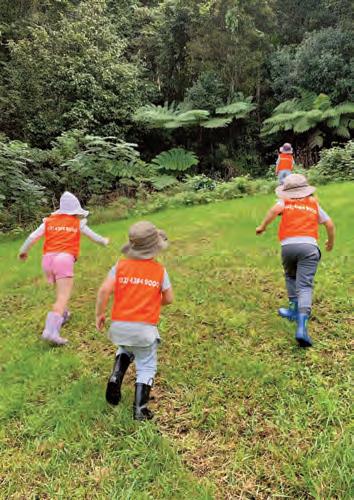
over the different seasons we also take the opportunity to make observation and note with the children on changing of conditions in the environment. One feature that really encompasses this is the huge maple tree that we see change from bright green leaves, to yellow and red leaves that drop to the ground and the brown branches empty, ready for more growth. For us as educators, this also acts as a symbol and a reminder of the growth and journey of our own children.
Exploring water; In the middle of our wild space, around a pond, we observe the ever-changing body of water. Much of our exploration is based around the science-based elements of the water and the living organisms within it. Through our adventures, the children explore
concepts such as buoyancy, volume and matter. We hypothesise and research the algae, plants and creatures living in the water and continue this research back at Alkira ELC. Water provides us opportunities to discuss differences in water bodies as well as the important skills of water safety especially pertinent living in our coastal region. We are very proud and passionate about our adventure program here at Alkira ELC. It is not only for the pure joy it brings the children but the benefits we see in the children’s growth, confidence, learning and behaviour that inspires us to continue to develop and tweak this special activity that has continued to run every year since its inception in 2015. Currently, led by our outdoor and adventure facilitator, with a certificate in Nature Pedagogy, our team is continuously challenged to provoke the children’s learning while they explore, research, experience, take risk, build memories and connect with nature.
Celebrating TWO YEARS OF SERVICE TO OUR COMMUNITY Wait list open call us on 4384 9000 to book a tour Celebrating ARS OF SERVICE COMMUNITY it list open call us on 384 9000
k a tour A community focused on happiness, education and belonging. A place to shine
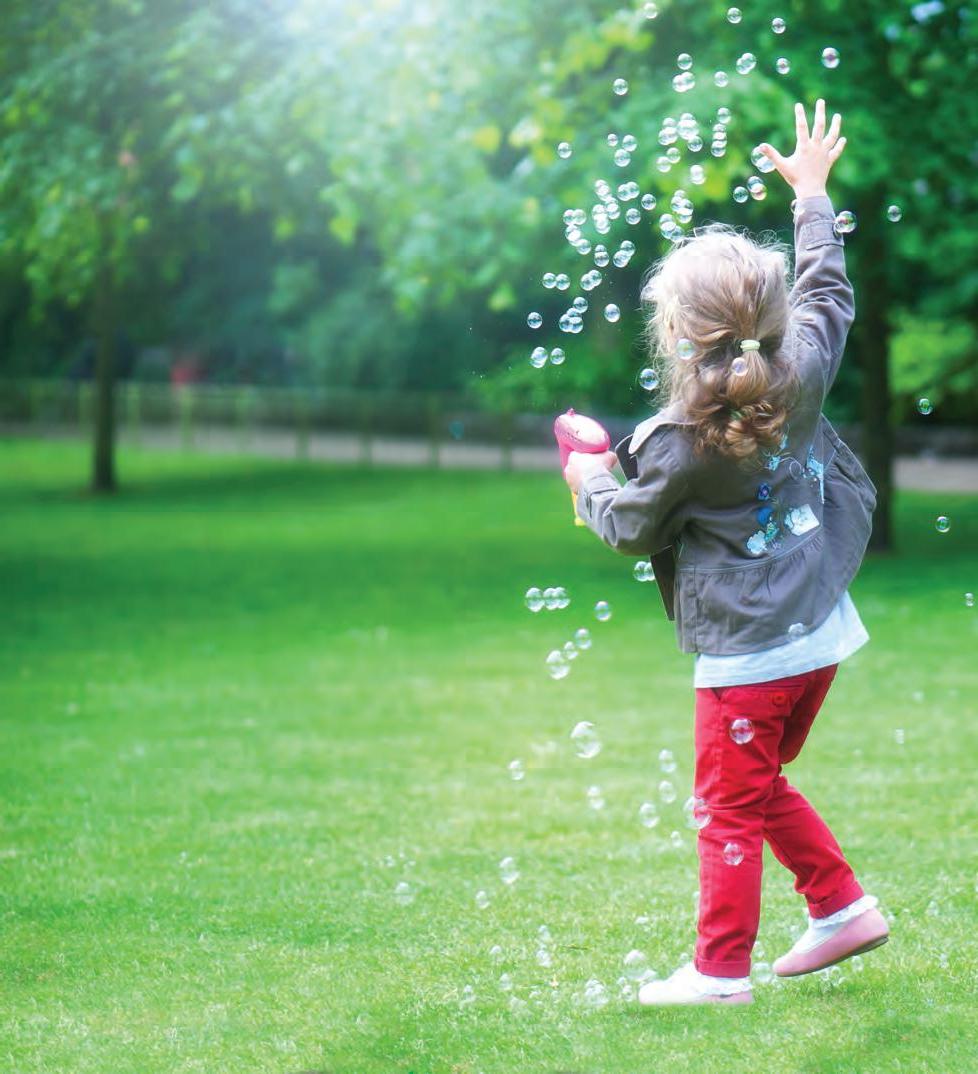
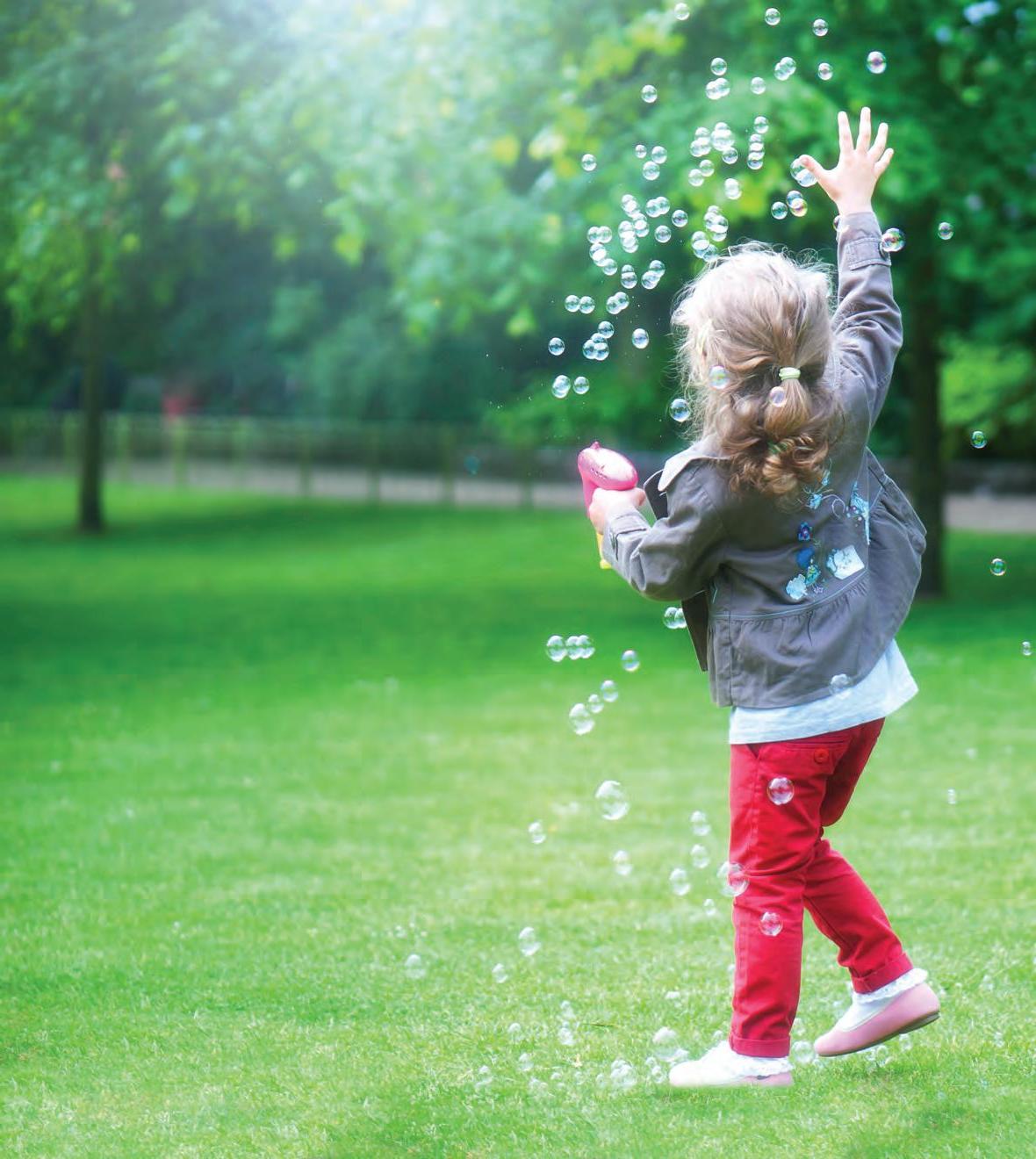

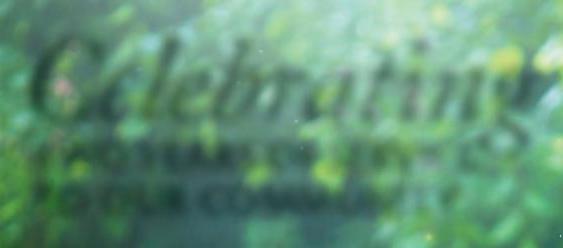
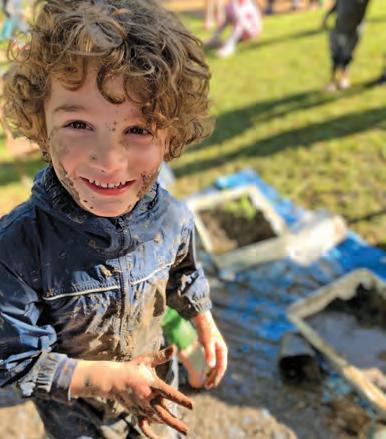
A place to shine A community focused on happiness, education and belonging. A community focused on happiness, education longing. Currently enrolling for 2020 Call us on 4384 9000 to book a tour.
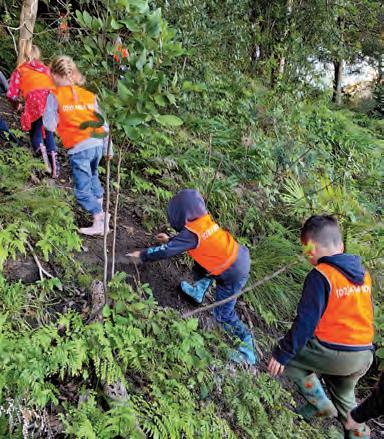
1 Reads Road, Wamberal /alkiraearlylearningcentrewamberal www.alkiraelc.com.au 1 Reads Road, Wamberal A place to shine Open from 6:30am to 6pm Monday to Friday Catering for Children aged 0– 6

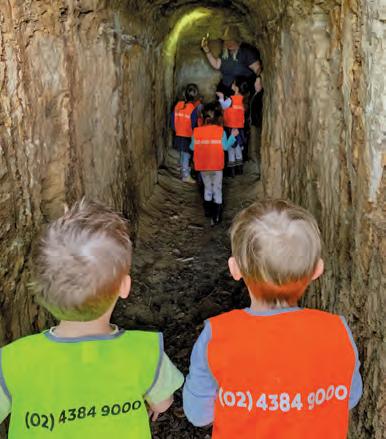
Alkira_elc
www.alkiraelc.com.au
Alkira_elc
